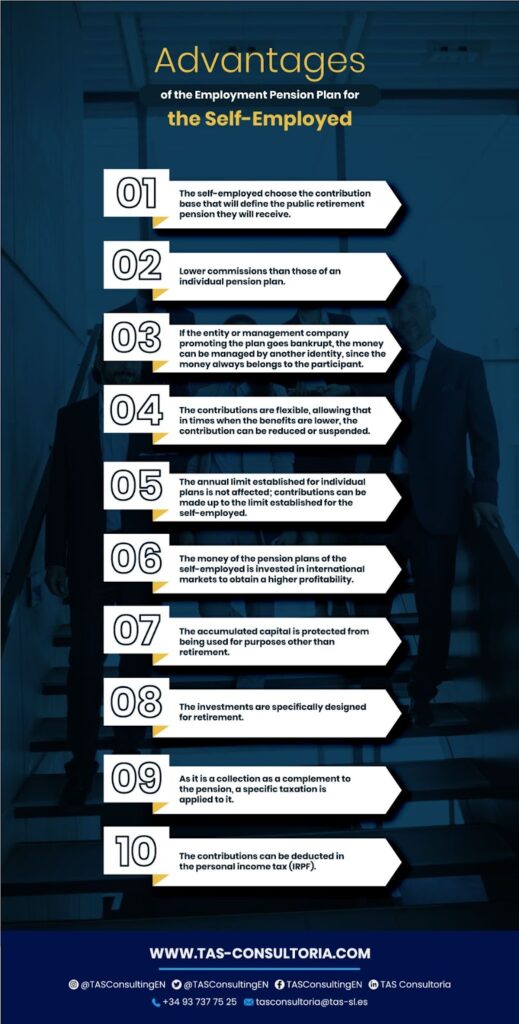
This 2023, the Employment Pension Plan for the Self-Employed promoted by the National Federation of Self-Employed Workers’ Associations (ATA) will allow citizens to benefit from the increase of the IRPF tax limit. This being so, the pension assets will be invested taking into account the profile of the self-employed. If you want to know more about this plan and how it can help you if you are self-employed, stay with us until the end.
What is the Employment Pension Plan for the Self-Employed?
The occupational pension plan is a financial instrument focused on saving for retirement. Its purpose is to generate savings to supplement the pension received by the self-employed from the state.
It works in such a way that the professional makes periodic or one-off contributions to the plan and, if he/she wishes, can suspend them temporarily or permanently. In addition, these funds will be invested taking into account the profile of the self-employed participants in the plan, considering the profitability, risk and social and environmental impact of the investments.
To give you an example, if a pension plan is promoted by a professional association through a mutual provident fund, it could be considered as a simplified occupational pension plan.
You may also be interested in: How to become self-employed in Spain if you are a foreigner?
What is a simplified employment plan?
Significant occupational pension plans is one of the novelties included in the draft bill for the promotion of occupational pension plans.
They are designed to help improve the savings of the self-employed and SME employees. Generally, they are plans that are promoted by the companies themselves and are included in the statutory collective agreements of a social nature.
In addition, those plans that are recognized as public sector employment pension plans that include any local corporations, entities and agencies that depend on them will be considered simplified plans.
In the same way, the pension plans of the self-employed promoted by the labor associations will be recognized by the professional associations or by the mutual benefit fund.
What is the purpose of the pension plan for the self-employed?
The objective of this pension plan is to eliminate the complexity and administrative burdens of current occupational pension plans for promoters, companies and entrepreneurs. In addition, this simplification helps to improve the savings capacity of self-employed individuals and SME employees.
However, there are still many doubts as to how the issue will be at the time of retirement, since many conditions governing these new plans have yet to be defined.
The only thing that is clear so far is that these plans will help the self-employed to save for the future, with a higher contribution that will allow them to enjoy a complementary income to Social Security at retirement.
What are the advantages of the Employment Pension Plan for the Self-Employed?
As we told you, pension plans, especially the Employment Pension Plan for the Self-Employed, can be considered an efficient instrument for saving. Because of this, it generates many advantages for you as a self-employed person, for example:

Which self-employed workers can benefit from the occupational pension plan?
Current regulations allow some self-employed workers to participate in an employment plan and obtain multiple benefits:
- The self-employed employer, the one with employees hired directly as self-employed without having a company. He/she can promote an employment plan for his/her employees and at the same time can participate in the plan.
- The corporate self-employed person has an employment relationship with the company of which he/she is the administrator. In this case, in order to be part of the employment plan, he/she must ensure that he/she has more employees participating in the plan.
You may also be interested in: Pros and Cons of Venture Capital Fund Financing
How are the contributions for the pension plan for the self-employed?
The way in which this employment plan can be amortized will vary according to the needs of the self-employed. Therefore, they can be:
- The contributions will always be made by the self-employed person on a voluntary basis.
- They can be periodic or one-time contributions, which can be modified in amount or frequency, and it will also be possible to suspend payment.
- In no way may they exceed the legal limits established annually.
- You can accept withdrawals from other pension plans, as they will not affect the legal contribution limits.
How much can be deducted in income tax?
As we said, one of the advantages of the pension plan for the self-employed is the tax deduction in the income tax return. Let’s remember that before the modification of the regulations, €1500 could be deducted.
Now, with the new regulation, it will be possible to deduct up to €5,750 with the pension plans for self-employed promoted by associations, professional associations and other organizations. Thus, professionals will be able to benefit from the deductions in the income tax return.
What steps should you follow to join a pension plan for the self-employed?
Although there are still few entities that manage a pension plan for the self-employed, the following steps can be taken to join one of these plans:
- Present yourself at an office of an integrity that offers the pension plan.
- Obtain information about the requirements you must meet.
- Collect the necessary documentation. Among them, the proof of being registered in the special regime for self-employed workers (RETA).
- To comply with the contributions deemed appropriate.
What options do you have to pay for a Employment Pension Plan for the self-employed?
The most common ways to pay a pension plan for self-employed can be of:
- One-time payment (capital).
- Periodic payments (rent).
- Payments without a regular periodicity.
- Combined payments between capital and rent.
When a special case arises, as in the case of serious illness or long-term unemployment, the only form of payment available is immediate capital.
You may also be interested in: How to obtain a loan in Spain?
If you are interested in creating an Employment Pension Plan for self-employed and do not know how to do it, contact us through our email tasconsultoria@tas-sl.es. Here we have the best advisors who can guide you step by step in the creation of your plan.
Don’t let time pass and ask for your free consultation. So you can start enjoying the benefits that this plan can give you.
.




Your email address will not be published .
Required fields are marked with *